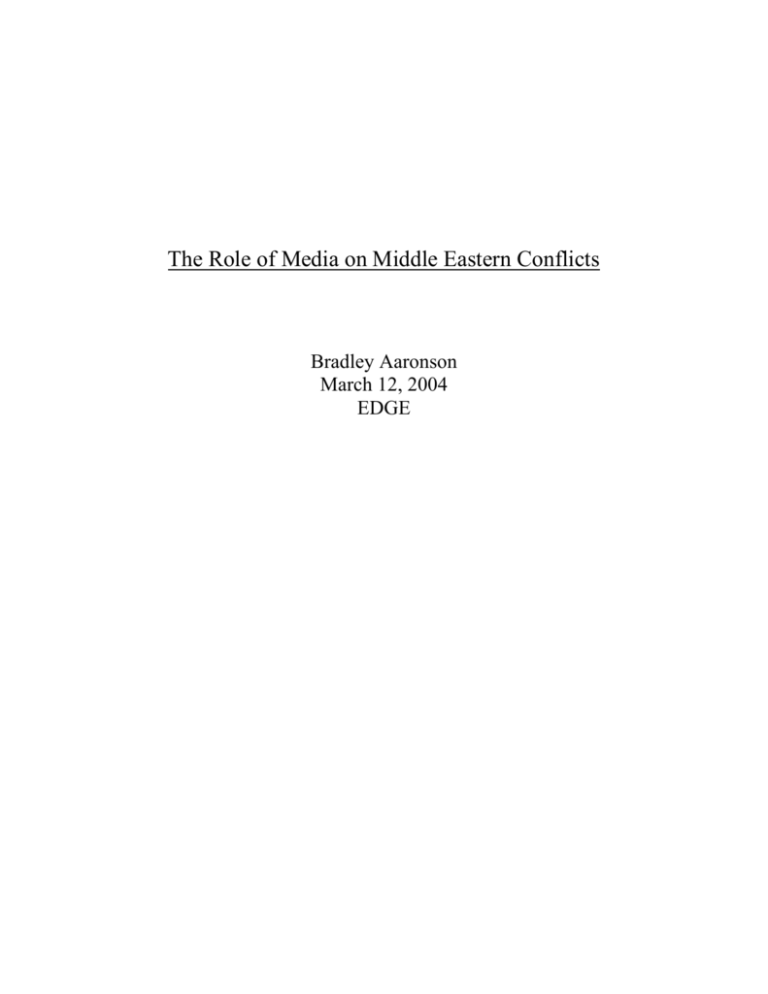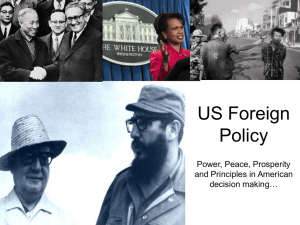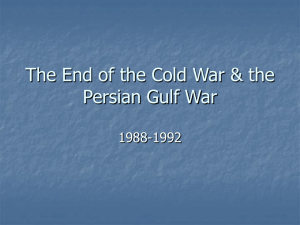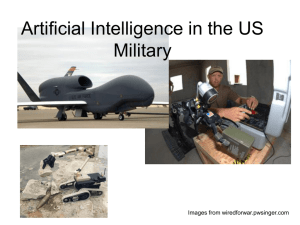The Role of Media on Middle Eastern Conflicts
advertisement

The Role of Media on Middle Eastern Conflicts Bradley Aaronson March 12, 2004 EDGE “By now, all of us realize that there is a high powered media campaign aimed at promoting the war on Iraq and shaping the views of the American people, relying on media-savvy political strategy to sell the administration’s priorities and policies”1 “Systematic sources of bias in TV coverage of international affairs not only distort information, but can also restrict citizens’ awareness and options, and thereby produce more social control. The focus here is on the way TV news formats can limit, constrain, and distort information about terrorism.”2 The relationships between countries in the Middle East and with the West have never been ones of peace or tranquility, and in recent years these relationships seem to be headed in a downward spiral. Currently, there has been an increasingly intense clash between the citizens of all societies that is largely a reaction against what is perceived through the news media about the other society. While the general public goes about watching their favorite nightly news broadcasts, they are unaware that the very knowledge they hope will educate them about the Israeli-Palestinian conflict and the War in Iraq, is actually one of the primary factors leading to the strain between our two differing societies. This is largely the result of the way news coverage is produced and presented in the United States, the Middle East, and around the world. In the United States, there are many facets that determine how news about the Middle East is produced and presented. Ultimately, these news reports determine how the American people view Middle East societies and unfortunately, how they view people of Middle Eastern ethnicity within the United States. The media’s causal effects, however, on the conflicts in the Middle East as a result of the portrayal of both sides and the influences it has on people’s perceptions about the situation, cannot be solely blamed on the media itself, but Danny Schechter of mediachannel.org; “The Link Between the Media, the War, and Our Right to Know” David L. Altheide; “Format and Symbols in TV Coverage of Terrorism in the United States and Great Britain”; International Studies Quarterly (1987) 31, 161-176 1 2 can be attributed to the underlying factors that influence media companies. Among these underlying factors responsible for media’s societal influence is the relationship within the United States between our government and the companies that control our media. Relationships between governments and media companies around the world, created in the best interests of both parties, severely hinder people’s ability to receive objective information on which to base their opinions about their government’s policies and actions. This leads to an egregious misunderstanding and misrepresentation of world politics and issues, which receive substantial amounts of media airtime. Despite the despairingly negative influence that our large media conglomerates are having on shaping our political environment, it is important to investigate the role of non-profit media organizations in the distribution of information about the conflicts in the Middle East to further determine causality of our current societal climate. Finally, the analysis of government and media behavior in effecting the relationships between countries within the Middle East and with the United States must be used to determine policy implications that will better serve our societies worldwide. One of the main dynamics that defines television news broadcasts is the style of production and presentation used. There are several styles that news stations employ to cover news stories, including episodic and thematic, also known as backgrounder, coverage. In the United States, “Television news is…primarily episodic, taking the form of an event-oriented report that depicts public issues in terms of concrete instances” (Iyengar; 513). While this event-oriented style is good for describing a specific instance, it often lacks essential background information that is key to understanding the entire Ansolabehere, Behr, and Iyengar. “The Media Game: American Politics in the Television Age”; New York: Macmillan 3 scope of a situation. Episodic coverage of Middle Eastern affairs does not provide the historical context of the situation or the social context of the actors involved, such as the Islamic jihad or members of Hamas. This information would greatly increase the American public’s awareness and knowledge of the true situation unfolding in the Middle East. For example, “On the September 9, 2003 broadcast of ABC World News Tonight, Hilary Brown reported: ...This suicide bomb attack comes as no surprise. After Israel attempted to assassinate the spiritual leader of Hamas, Sheik Yassin...Hamas vowed revenge. What many in the media apparently prefer to ignore — or refuse to believe — is that Hamas is engaged in a long term campaign of violence — regardless of Israeli actions… Palestinian attacks have been regularly characterized by many in the media as ‘revenge’ or ‘retaliation.’ Such references reverse cause and effect, and wrongly suggest Hamas attacks are merely reactive. In fact, Hamas needs no provocation to attack, since it considers Israel’s very existence provocation enough” (CAMERA.org4). As is apparent from this example, episodic coverage is not representative of a full, in-depth story that is necessary for a complete understanding of the circumstances that surround an event. Using the example of the episode based story of Hamas provocation, it is clear that if one receives his or her sole knowledge about Middle East issues from news broadcasts, he or she would have a very misunderstood perspective of the circumstances that fuel the unrest in the Middle East. A second aspect that leads to a lack of historical and social context in the case of the current War on Iraq, is the issue of embedded reports in Iraq whose main job is to report back on specific incidences that occur within the area of their assignment. 4 CAMERA.org stands for Committee for Accuracy in Middle East Reporting in America CNN’s anchor, Aaron Brown, said during one broadcast that the embedded reporters give us “snapshots” of what is going on, “and it is our job here to put it all together.” ABC’s George Will observed somewhat more elegantly that “today’s problem – live television from journalists with units engaged in Iraq – is the problem of context. What was really missing were the kinds of stories that came out of Vietnam: the up-close and detailed stories with beginnings, middles, and ends; the gritty, gripping stories about people and courage and fear and heroism. It did not matter that it took days for those stories to make it back to the States and onto the air.5 As stated above, one way to cure that warped perspective would be through thematic or background programming, which provides “related background material and in-depth, interpretive analysis,”(Iyengar 52) that allows for a greater comprehensive understanding of a situation. The problem, however, is that “The networks simply don’t have time available to present thematic background on all newsworthy issues” (Iyengar; 52). Unfortunately, the lack of thematic background programming is responsible for the lack of knowledge Americans carry with them about Middle Eastern affairs and this information would permit a better understanding of the society as well as ease some of the negative sentiments the episodic “headline stories” bring about in the United States. Along with the episodic style used by broadcast stations to cover the news, another characteristic factor that determines which issues will receive coverage, is appropriateness of the story to the audience. In today’s society, as is the case any time there is conflict between countries, the continued struggle and ensuing war between the United States and Iraq has received countless hundreds of hours of coverage by the American media. The main reason is, because this has continued to be a persisting international crisis and because there are hundreds of thousands of U.S. soldiers fighting in Iraq, nearly all stories on the subject are considered suitable for the American 5 Paul Friedman, Columbia Journalism Review; “The Real-Time War TV: A Missed Opportunity” audience. Yet, to what extent these stories are accurate and complete is entirely questionable. Under normal circumstances, however, these stories are not as intriguing to audiences. “For most Americans, politics and government are not high-priority matters. Therefore, reporters must be able to simplify complex events or issues into understandable ‘stories’” (Iyengar 55). Just as episodic coverage leads to a partial view of a situation, so too does “simplification” further limit total understanding of an issue and hinder people’s access to knowledge. For example, “It has become a common, almost clichéd image in coverage of the Israeli-Palestinian conflict: forlorn children scampering across the rubble of their demolished homes. When Israel demolished three apartment buildings Oct. 26, 2003, in the Gaza Strip town of al-Zahara, photo services [Reuters and Agence France-Presse] sent out the standard images…In fact, despite the multitudes of photos implying otherwise, not a single Palestinian lost his home that day” (CAMERA.org). What was also not mentioned is that the action followed a Palestinian infiltration into a Jewish settlement in which Israeli off-duty soldiers were killed. As seen here, a simplification of the issue, or more accurately a lack of the full story, impinges on people’s ability to grasp the full scope of the situation and limits their capacity to have a true understanding of the state of affairs. Another key facet that defines production and presentation of news coverage in the United States is the idea of accessibility: “the feasibility and cost of covering particular events or issues” (Iyengar 51). Within Iraq today, there are a fixed number of American reporters who report on the actions of the American military within the country. This means that there are only a limited number of stories coming out of the country, which are then picked up and published by numerous broadcasts and publications within the United States. The problem is, however, that the same contextual or underlying information is missed when the same stories are picked up by many broadcasts entities. When the entire American media continually ignores the same issues and stories, this leads to a naïve and uninformed American public, who may have otherwise had an entirely different outlook on the Middle East and the world. While these facets of media production and presentation have restricted the way in which news coverage of the Middle East is produced in the American media, it must be noted that the disconnect between the citizens of both American society and Middle Eastern societies cannot be wholly blamed on the United States’ news coverage. The continuing conflict between the two completely differing cultures is a result of the negative portrayal of the other in the news. Just as the American media is guided by sensationalized stories, the news media in the Middle East is guided by their own set of principles, ones that are almost entirely devoted to the denouncement of Israel and the United States. In a New York Times article published on May 12, 2002, entitled “Global Village Idiocy,” the author Thomas Friedman recalls watching the Arab News Network in Dubai, “It was running what I’d call the ‘greatest hits’ from the Israeli-Palestinian conflict: nonstop film of Israelis hitting, beating, dragging, clubbing, and shooting Palestinians. I would like to say the footage was out of context, but there was no context. There were no words. It was just pictures and martial music designed to inflame passions.” Coupled together, the American media and the Middle Eastern media feed the continuing hostilities toward one another through misrepresentation of the other culture. As is portrayed through these examples, because American and Middle Eastern news coverage is produced and presented in these subjective formats, the citizens of both societies cannot obtain a true portrayal and thus a truly knowledgeable understanding of world affairs. Through this deficiency comes naivety, and with their naivety comes negative consequences such as a fear of that which is foreign. In recent months there has been an increasing surge of negative sentiment toward Middle Eastern people and culture and a decreasing acceptance of friendly existence within the United States. Such as the Muslim woman in Florida who was called “hypersensitive” in regard to her religion when she refused to remove her veil for a driver’s license photograph.6 This example of harmful behavior and many others like it must be attributed back to the providing source of information. In the case of the United States, these negative traits can be traced back to the negative influence the news media has on people’s depiction of the Middle East. Until news coverage in the Middle East, and especially in the United States, can be produced and presented objectively, in order to accurately depict the other society, the Middle East and the West will continue down their negative path of misunderstanding, hatred, and violence. While this evidence regarding the presentation and production of news generates confirmation that the media is responsible for the accruing lack of objective information and increasing misperceptions about other cultures, the underlying economic and societal influences that act on media entities must be analyzed in order to determine the true cause behind the media’s current devolution of skewed and incomplete news. One of the largest and most debated influences on media companies is their relationship with government administrations and the result that that political pressure has on the information broadcasted by media companies to citizens within those countries. Accusations of political “spin” and biased reporting in favor of current administrations seem to be 6 Dana Canedy; The New York Times; “Lifting Veil for Photo ID Goes Too Far, Driver Says” everywhere in the recent wave of media analysis, and while a majority of these accusations come from the relationship between American media companies and the United States government (which shall be discussed ad nauseam below), it is important to note that political influence on media entities is an internationally growing phenomenon that is increasingly responsible for the subjective information received around the world, and the subsequent misrepresentations that lead to violence and hatred. In the increasingly heated debate over pro-Israeli versus pro-Palestinian media representation in the United States, the extent to which foreign government officials from the Middle East are responsible for the inflow of falsified or skewed information is astounding. Much of this can be attributed to a political “jockeying for position” in which foreign government leaders try and portray their side in a good light or as the victim of some human rights violation in order to encourage increased sympathy and support for themselves and hatred for their opponents. Because of the turmoil between Israelis and Palestinians over the sacred land they both claim to be rightfully entitled to, a political game of “whose fault is it and who is the rightful owner” is being played between the two cultures to gain sympathy for their respective causes. Israel would like the press to reflect its view that it’s acting in self-defense. It’s the Israelis, they argue, who are under siege and are straining to convince the world that they, just like the U.S., are fighting terrorism. In the spin wars, the Israelis’ big gun is Raanan Gissin, media adviser to Prime Minister Ariel Sharon…[And while] making the rounds of Jerusalem Capital Studios, where just about every foreign media outlet has offices, Gissin is shopped around from CNN, to BBC, to Reuters and AP, then Fox, and on and on, offering the Israeli take of the day.7 As well, the Palestinian side wants to be portrayed in the media as the real victim, whose actions stem from being an oppressed and occupied people. The media standard bearers are 7 Steve McNally, Columbia Journalism Review; “Letter From Jerusalem. Caught in the Middle” spokespeople such as Saeb Erekat, chief negotiator, and former legislator Hanan Ashrawi. But they are sometimes undermined by the rest of the Palestinian spin machine, which has fewer resources and less experience than the Israelis. It also tends to exaggerate the circumstances or the numbers of people killed or hurt in clashes with Israelis.8 Because of the United States’ history of supporting Israel, both financially and militarily, media broadcasts and publications are often accused of being pro-Israel, and while some evidence does exist to support this theory, it is often cited that “It’s not a conspiracy by any means, but what it boils down to is [the media] depend on government officials. And these government officials represent the administration, which tends to be pro-Israel.”9 Yet, what is the true cause and effect relationship at work here? This argument states that the media is dependent upon government officials who represent government administrations. Meaning that the news media is reliant upon government officials relaying information from government agencies to media entities so that it can be broadcast to the citizens of the country. However, couldn’t it be argued that decision makers rely on information [gathered through the media], reflecting the concerns, capabilities, and orientations of their adversaries, which is a key factor in influencing government negotiation strategies in periods of conflict?10 There is little evidence to suggest that either of these arguments is untrue, but what it does suggest is a contradiction between the roles of government providing information to the public and inherently relying on this information to conduct strategy. As shall now be examined, the relationship between media companies and the current United States Bush administration 8 Steve McNally, Columbia Journalism Review; “Letter From Jerusalem. Caught in the Middle” Quote by David Demers of the Center for Global Media Studies. Brendan O’Neill; “Our Pro-Israel, ProPalestinian Media” 10 Mohammed el-Mawawy and James D. Kelly; “Between the Government and the Press. The Role of Western Correspondents and Government Public Relation in Middle East Coverage” 9 seem to rely on the former relationship, but this relationship has implications for the type and accuracy of the information American citizens receive. As was discussed and argued at length during the 2000 Presidential Election and again immediately before the outbreak of war in Iraq, the success of George W. Bush’s presidency would be determined by his foreign policy decisions and the subsequent results of those decisions on the Israeli-Palestinian conflict and the Iraqi War. For this reason alone, it is blatantly obvious that the President must rely on the American news media to relay positive images of the American involvement in the Middle East to the citizens of the United States. The President has made this feat somewhat successful through his administration’s relationships with owners of controlling media companies, but this has come at the expense of American citizens receiving subjective information designed to formulate specific opinions, one of which is American patriotism. The United States media’s disorder over the Middle East tells us something about the U.S.’s changing relationships to the Arab-Israeli conflict. In the recent past, American-Israeli groups have become increasingly isolated from foreign policy circles in Washington and instead have been reduced to complaining about words and images in U.S. newspapers.11 This has taken some heat off the government as being completely pro-Israel, but it does not change the fact that the government’s intimate relationship with media companies has a direct effect on the information American citizens receive, whether pro-Israel or not. The relationship between the American government and American media companies has always been based in money and political pressure, and for the current Bush administration, governing in a time of extreme worldwide conflict, this could not be 11 Brendan O’Neill; “Our Pro-Israel, Pro-Palestinian Media” more true. Unfortunately, it is this corrupted relationship that is responsible for the prejudiced news we receive here in the United States. Media companies have shown that they have deep pockets when it comes to politics, with the level of contributions made over the last decade growing ninefold, while recent research shows that the trend for political donations by US television and radio stations has almost doubled in the last year.12 Most often, political contributions come from media companies whose “donations are typically representative of their economic interest and are dictated by whoever is in power” (Lawson). For this reason, it is not surprising that Rupert Murdoch’s News Corporation and General Electric, the owner of NBC, gave large sums to the Bush campaign and are incisive supporters of the war in Iraq. It would be a blatant fabrication to say that this relationship provides no political influence on the information or news broadcasted from these stations. In this time of extremely polarized opinions throughout the United States and the world about what should be done as the unrest in the Middle East escalates, it is of little surprise that, “few administrations in history have been as adept at using polling, focus groups, ‘perception managers,’ spinners, and ‘information operations’ specialists to sell slogans to further a ‘patriotically correct’ climate…Our Republican Guard relies on Murdoch-owned media assets like the Fox News Channel, supportive newspapers, aggressive talk radio hosts, conservative columnists, and an arsenal of on-air pundits adept at polarizing opinion and devaluing independent journalism” (Schechter). President Bush’s use of friendly media resources, especially those assets of Rupert Murdoch, has become so egregious that their relationship was recently highlighted when it was discovered that Roger Ailes, a former Republican party 12 Annie Lawson; “US Media Dig Deep for Politicians” April 7, 2003; mediaguardian.co.uk strategist and the current Fox News Channel chairman, secretly advised the president in the days after the September 11 terror attacks.13 This relationship, in the context of political influence and pressure, is akin to what can be described as government-imposed censorship. In the current wave of media consolidation, the number of companies controlling our media has dropped from fifty to between five and seven in the past ten years. In recent news, the Federal Communications Commission is expected to relax broadcast regulations and whether or not there is a connection between the FCC’s change and the Bush administration’s influence can be debated. Although, “is it unthinkable to suggest that big media companies who stand to make windfall profits once Colin Powell’s son, FCC chief Michael Powell, engineers rules that permit more media mergers and concentration?” (Schechter)(emphasis added). As well, on a more personal level, during Bush’s presidency, which has been heavily involved in the Middle East conflict, even journalists are being intimidated for stepping out of line. For example, Pulitzer Prize winner Seymour Hersh was criticized as being a “media terrorist” by Pentagon advisor Richard Perle. MSNBC’s Ashleigh Banfield was ostracized by her bosses at the GE- and Microsoft- owned channel, the same men who fired top-rated Phil Donahue and then used the war to try and out-fox Fox’s jingoism with promos proclaiming “God Bless America.”14 Any political leader, when asked about the aspects that go into a successful plan of action, will tell you that good press is essential and that bad press is always the bane of any plan’s existence. The same is true for the Bush administration’s policies toward the 13 Annie Lawson; “US Media Dig Deep for Politicians” April 7, 2003; mediaguardian.co.uk 14 Danny Schechter of mediachannel.org; “The Link Between the Media, the War, and Our Right to Know” Israeli-Palestinian conflict and the War on Iraq, and this provides key insight into why the government might intervene and dictate what information is broadcast. While it was stated before that embedded reporters can provide minute-by-minute detail of fighting on the front lines of Iraq at the expense of context, in this example, this type of journalism actually benefited the American people, much to the dismay of the Bush leadership. Embedded reporters in Iraq were the first to relay back indications that the campaign against Saddam Hussein was not going as predicted and because this information was coming in so quickly, it was quite different from the initial pictures of rapid advances by U.S. forces. During this time, Defense Secretary Donald Rumsfeld argued that the plan was working, but what he failed to take into account was that Day after day the embedded reporters were gathering evidence at the scene…[and that] means that some soldiers get chummy with journalists – and they talk. They talk about bad decisions, malfunctioning equipment, dwindling supplies, and an enemy that wasn’t rolling over the way it was supposed to.15 Indeed, this information is what eventually led to the barrage of criticism launched against President Bush’s plans for war in Iraq. Before the war, the administration tried to sell the American public on the idea of war by convincing them that background briefings predicted a relatively quick, easy fight and minimized worries about troop levels and long supply lines.16 As we have seen now that the situation has relaxed slightly, this information in fact contained no truth at all. Based on these myriad examples, it appears that our media system is entrenched in a very measured structure of misinformation and misrepresentation, which in turn 16 Paul Friedman, Columbia Journalism Review; “The Real-Time War TV: A Missed Opportunity” severely limits people’s access to qualitative and objective information both here in the United States, in the Middle East, and around the world. Yet, in what ways does this media system need to be overhauled in order to reduce, and if possible completely eliminate, the biased information received daily around the world. One possibility, although not entirely feasible at this point in time, is the continued funding and increased prevalence of non-profit media organizations that provide in-depth, objective information on which people can make informed opinions about different issues. One such non-profit TV channel is WorldLink TV, which aired an Australian film maker John Pilger’s documentary entitled “Palestine Is Still the Issue.” Pilger approached many big American media corporations such as CNN, Fox, NBC, and TBS in the hope of diffusing his film, but he was rejected by all of them on the grounds that the film used anti-Semitic arguments and “offensive language” toward Israel.17 While this documentary may possess biased information itself, the fact that WorldLink TV chose to air it allows people the opportunity to make their own informed opinions about the film. Others believe that “If we want to save our democracy, we have to press the media to do its constitutionally protected job as a watchdog on people in power. We must insist that all views be given access, and that concerns of critics of this administration be heard and debated” (Schechter). Robert McChesney, the author of an article entitled “Media too Influenced by Their Corporate Owners” suggests ideas that, if implemented in some form, would correct for the egregious actions of the media companies and the government discussed herein. “In moments of crisis, the media system needs to generate factual accuracy on everything relevant. It needs to provide a wide range of debate over policy proposals to 17 Ndzana Seme; “Apartheid is The Issue in the Middle East” address the crisis. And it needs to provide the necessary background and context so that citizens can make sense of the problems and determine the best possible solution.” Because the structure of the current media system both at home in the United States and abroad is inherently flawed, based on its inability to provide objective news without the possibility of individual bias, people around the world cannot attain an accurate depiction and thus a truly educated understanding of world affairs. This lack of knowledge leads to a host of consequences, one of which is the violence that comes from those naïve to that which is different. As well, an increased sense of apathy toward government policies and our administrative leaders has enveloped our country because a majority of the American public is aware of the faulty nature of our media system. As a result of the multitude of structural problems that plague the media system, which include all of the examples presented here, people’s perceptions about the conflicts in the Middle East, both the Israeli-Palestinian conflict and the war in Iraq, are skewed and are an inherent cause of the continued clashes resulting from misconceptions about others.






